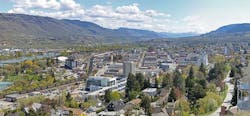BC city Kamloops exploring development of District Energy network for community
The town sometimes billed as the Tournament Capital of Canada is exploring low-carbon district energy in partnership with a local university.
The British Columbia city of Kamloops signed a memorandum of understanding with Thompson Rivers University and Creative Energy on the possibility of connecting the city to a district energy system. Earlier this year, the university of developer Creative Energy partnered on developing a district energy network to heat campus infrastructure.
Creative Energy for years has developed a wide-ranging district energy system utilizing steam power and electricity over areas including part of Vancouver. The company operates more than 15 kilometers of pipling connecting to many buildings in the area.
The new MOU would tap the city of Kamloops into the system currently under development.
The agreement “marks a significant step forward in achieving goals laid out by our community climate action plan,” Mayor Ken Christian said in a statement. “By working together toward a common goal of reducing greenhouse gas emissions, we’re helping to create a healthier community for future generations.”
The first phase of the low-carbon district energy system is expected to be complete by 2025 and will eliminate over 90% of greenhouse gas emissions from nine TRU-owned buildings in Kamloops.
Many national and regional sports tournament are often located in Kamloops due to the Tournament Capital Centre facility located near the university campus.
District heating, often fueled by geothermal loops or combined heat and power plants producing steam, is a popular low-carbon method for many universities and municipalities.Among those utilizing district heating include MIT, Depauw, the city of Leeds, UK, and school districts in Maryland.
About the Author
Rod Walton, EnergyTech Managing Editor
Managing Editor
For EnergyTech editorial inquiries, please contact Managing Editor Rod Walton at [email protected].
Rod Walton has spent 17 years covering the energy industry as a newspaper and trade journalist. He formerly was energy writer and business editor at the Tulsa World. Later, he spent six years covering the electricity power sector for Pennwell and Clarion Events. He joined Endeavor and EnergyTech in November 2021.
Walton earned his Bachelors degree in journalism from the University of Oklahoma. His career stops include the Moore American, Bartlesville Examiner-Enterprise, Wagoner Tribune and Tulsa World.
EnergyTech is focused on the mission critical and large-scale energy users and their sustainability and resiliency goals. These include the commercial and industrial sectors, as well as the military, universities, data centers and microgrids. The C&I sectors together account for close to 30 percent of greenhouse gas emissions in the U.S.
He was named Managing Editor for Microgrid Knowledge and EnergyTech starting July 1, 2023
Many large-scale energy users such as Fortune 500 companies, and mission-critical users such as military bases, universities, healthcare facilities, public safety and data centers, shifting their energy priorities to reach net-zero carbon goals within the coming decades. These include plans for renewable energy power purchase agreements, but also on-site resiliency projects such as microgrids, combined heat and power, rooftop solar, energy storage, digitalization and building efficiency upgrades.

